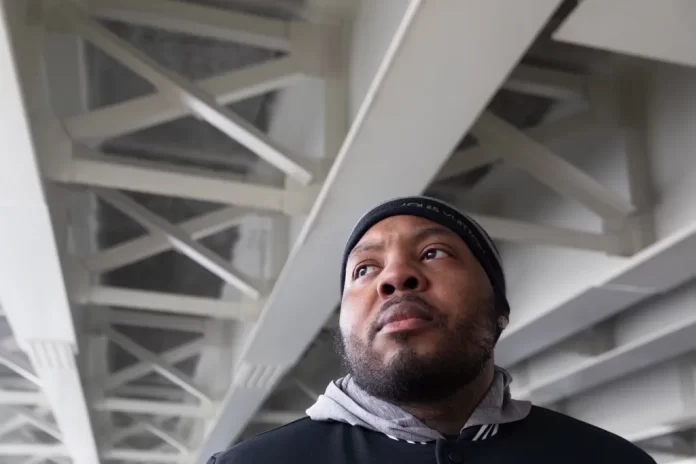This story was originally published by Signal Statewide. Sign up for free newsletters at SignalOhio.org/StateSignals. Statewide is a media partner of the Toledo Free Press.
OHIO – In the final month of his two-year prison term, a guard ordered Lamont Clark Jr. into a cramped office.
Against the blurred background of a computer screen, a professionally dressed woman appeared on camera and explained that Clark would not be going home to Cleveland. A new state law required that he spend another year in prison.
The reason: Another incarcerated person claimed that Clark had attacked him in 2023 during a riot at Lake Erie Correctional Institution.
“They never told me who I allegedly assaulted. They just said, ‘Somebody said you assaulted them, and you’re guilty,’” Clark told The Marshall Project – Cleveland this year, after serving the extra time.
This article was published in partnership with The Marshall Project – Cleveland, a nonprofit news team covering Ohio’s criminal justice systems.
Hundreds of incarcerated people like Clark are denied release from Ohio prisons each year under Senate Bill 201, better known as the Reagan Tokes law. Tokes was raised in Maumee, Ohio in Monclova Township (near Toledo, Ohio) and graduated from Anthony Wayne High School.
Enacted in 2019, the law was designed to protect the public with a carrot-and-stick approach to incarceration. It gave prison administrators exclusive powers to add time for people who misbehave behind bars, or to recommend early release for those who follow the rules.
But as critics predicted, the law has only led to longer incarceration.
Not a single person has been released early, according to a Marshall Project – Cleveland review of prison records for the past six years. Meanwhile, 700 people — mostly Black men — have been denied release due to added time.
The Marshall Project – Cleveland investigation found no external oversight or internal auditing of administrative decisions to lengthen incarceration. People accused of violating prison rules are not afforded basic legal rights to have access to lawyers, to challenge their accusers or to review evidence.
“When you give this kind of unchecked power to people, it’s going to be abused,” said defense attorney Andrew Mayle, who fought for the law’s constitutionality to be challenged in the Ohio Supreme Court in 2023.
Nearly a third of Ohio’s prison population sentenced under new law
The law was the legislative reaction to the 2017 murder of Reagan Tokes, a 21-year-old Ohio State University student, by a man recently released from prison.
Lawmakers sought to ensure public safety by keeping other potentially violent people locked up longer.
This latest pendulum swing in Ohio’s criminal sentencing laws created a new class of incarcerated people who risk not only solitary confinement and loss of privileges, but also longer prison stays for violating rules. It’s a partial return to the indefinite sentencing that Ohio legislators replaced with fixed prison terms during the popular truth-in-sentencing movement of the mid-1990s.
Under the Reagan Tokes law, judges must again give minimum and maximum prison terms for first- and second-degree felonies.
More than 14,500 people, nearly a third of Ohio’s current prison population, have been sentenced under the Reagan Tokes law.
Critics argue that with no requirement to notify elected judges before adding some or all of the maximum term, lawmakers handed unchecked, extrajudicial power to unelected prison administrators.
Defense lawyers and advocates for incarcerated people had warned that prison officials would likely abuse the power to keep people beyond their minimum prison terms. But they remained cautiously optimistic that the Ohio Department of Rehabilitation and Correction might also reward people who follow rules and complete programming by reducing their terms.
But the agency’s reading of the law — choosing a more burdensome requirement for early release — has denied all of the more than 120 petitions by incarcerated people to reduce their minimum prison terms.
Meanwhile, alleged rules violations resulting in added time have amounted to about 830 more years of incarceration, costing taxpayers $32 million based on total operational costs per prisoner.
“This was never pitched as a one-way ratchet, where sentences only get increased and not decreased,” said Matthew Ahn, director of the Beyond Guilt project at Ohio Justice & Policy Center. “…What we have is just another accelerator toward runaway incarceration, toward runaway spending on corrections and imprisonment.”

The law’s implementation also tracks racial disparities that worsen the deeper people move into the criminal justice system. Black men make up less than 7 percent of Ohio’s population and a staggering 59 percent of those given additional prison time under the law. Cuyahoga County is home to just 10 percent of Ohio’s population and nearly 23 percent of those kept beyond their minimum sentences.
Ohio prison spokesperson JoEllen Smith said that director Annette Chambers-Smith “carefully reviewed and considered” each petition for early release before denying them all. Chambers-Smith declined to comment.
The denial of more than 120 requests for sentence reductions hinges on prison officials’ interpretation of the Reagan Tokes law, which established two criteria for early release: adjustment to incarceration or exceptional behavior. Nothing in state law or prison policy requires administrators to pick one or the other before recommending that sentencing judges shave up to 15 percent off minimum prison terms.
State rules define adjustment to incarceration as good conduct, a low security level and no affiliation with prison gangs. Prison administrators, however, say lawmakers set unattainably high standards for exceptional conduct, which include voluntarily completing community service and rehabilitative programming, keeping positive relationships with the outside world and mentoring others.
Critics have maintained all along that, to reduce returns to prison, lawmakers should have addressed the lack of positive programming in prisons.
“The problem with the Reagan Tokes Act has always been that it is more stick than carrot,” said attorney Nicole Clum, who advocated for a more balanced approach as a former legislative liaison at the Office of the Ohio Public Defender.
“If individuals are always given their maximum sentence and never given relief for good behavior, they have no incentive to engage in rehabilitative efforts,” she said. “Ohioans are better served if incarcerated individuals have hope.”
Otherwise, she added, there’s “no reason to engage in rehabilitation. Inevitably, this makes Ohioans less safe.”
Prisons don’t track the reasons people get additional time. So, The Marshall Project – Cleveland spoke to dozens of incarcerated people and reviewed documents in 30 recent cases through a public records request that took officials six months to fulfill. Rule violations for assaults and other sexual misconduct — up 45 percent and 75 percent, respectively, since 2019 — appear to be driving much of the additional time, the limited analysis found.
Prison administrators could not say whether the threat of longer sentences under the Reagan Tokes law might counter rising levels of violence in Ohio prisons. One official suggested that the law would have to apply to half of Ohio’s prison population in order to study its effect.
Those punished by the law describe being locked up with cellmates who violently lash out during mental health episodes or while abusing drugs.
Lifers with little or no chance of parole extort money and commissary funds from people marked by Reagan Tokes sentences. They’re easy prey, some men said. If they fight back, they risk more time in prison. Their aggressors know that, so they pay up or take their beatings.
“Somebody with life said they were going to stab me because we kept arguing. … So, I had to punch him. I had to defend my life in those circumstances,” said Edward Navone, who is spending an extra year at a maximum-security prison in Lucasville after correctional staff found him guilty of assault.
The new law isn’t just impacting prisoners, but taxpayers as well.
Some sentenced under the law say they are denied basic due process protections
When lawmakers introduced the Reagan Tokes Act in 2017, prison officials told the legislature that additional costs would be minimal if sentencing courts accepted their recommendations to reduce sentences for good behavior. But no such recommendations have been made
Instead, Gary Daniels of the Ohio ACLU more accurately predicted what would happen when he testified in a 2018 committee hearing on the proposed bill.
“Under a more realistic scenario, (the law) will dramatically increase our prison population by hundreds per year for the next several years,” Daniels said.
Former Ohio Sen. Kevin Bacon and Rep. Jim Hughes, Republicans who co-sponsored the Reagan Tokes Act with state Senate and House Democrats Sean O’Brien and Kristin Boggs, said any law is worth revisiting.
Bacon said he was “surprised” to hear that all requests to reduce prison terms have been denied.
“I’m hoping that it’s a case where … if it is imbalanced, it’s imbalanced to protect the public,” said Hughes, adding that the state is “dealing with the worst of the worst.”
Boggs and O’Brien are now judges. Neither would talk publicly.
The law provides no checks on how public or private prison staff allege and investigate misconduct, or determine guilt. There’s no external oversight and no annual auditing.
Disciplinary decisions made behind closed doors by appointed members of the Ohio Parole Board may be appealed to lawyers who work for the state prison system. But documentation from those decisions is exempt from public records laws. Judges, who would be required to approve early release, have no say in whether time should be added. They’re not even notified.
“Certainly the judge should have a say if you’re going to be held over,” said Mayle, the defense attorney who argued against the law.
Mayle said he could not think of a political or legal reason for removing judicial oversight other than to give unilateral authority to state prison officials.
“But then again, prisoners are not a very influential body politic. They are easy to dump on,” Mayle said, adding that “there is an economic incentive for people who work in the prison business, whether they work for private or public prisons, to have prisoners.”
Those most affected by the law say they’ve been denied basic due process protections.
Clark, like other men accused by fellow prisoners of rioting at Lake Erie Correctional Institution and later given extra time, was found guilty under a veil of legal and literal darkness.

A power outage hit the privately owned and operated prison in August 2023. The lights and camera went dark when the backup generators failed. Concerned for their own safety, correctional officers abandoned their patrols inside pitch-black pods.
With no surveillance footage or official witnesses, investigators relied solely on confidential sources — other incarcerated men — to identify the alleged rioters and swiftly move them into solitary confinement cells.
Until then, Clark had a clean disciplinary record. But investigators never asked him what happened the night of the riot. Instead, he and others received nearly identical conduct reports from the same investigator. Each report referenced confidential statements as the only evidence against them.
One incarcerated man told officials he was with Clark “all night and he never touched anyone.” It didn’t matter. Disciplinary records show that administrators believed the confidential sources.
Clark was loaded onto a bus as waves of men left Lake Erie Correctional Institution for higher-security and more violent prisons. As their scheduled release dates neared, one by one, they received their extra time.
Dozens of incarcerated people told The Marshall Project – Cleveland that the law’s lopsided rollout and its empty promise of rewarding good behavior had left them demoralized.
“It is frustrating,” said Jose Padilla III at Belmont Correctional Institution. “People get discouraged. When they find out they’re not getting out, that’s when they get a ticket (or rule infraction). People just give up. What’s the point?”
Several men said violence breeds violence. Fists and weapons are survival tools. More prison time doesn’t deter their use when people are threatened with physical harm or worse.
“They put a lot of people in bad situations and expect them to be angels,” said Clark, who was finally released from the notoriously violent Lebanon Correctional Institution in January after serving his extra year.
The Marshall Project – Cleveland also spoke to dozens of people who appear to meet the minimum eligibility requirements to petition for early release. At least four, including two who filed after being contacted by a reporter, were denied for reasons that included the crimes for which they are serving time.
“It just says past criminal history,” James Fleming said of the denial letter he received in June.
Fleming said he’s had no tickets in his three years of imprisonment. He’s been trusted with a maintenance job at Belmont Correctional Institution, a minimum security prison in southeast Ohio. He said he wants to better himself and atone for his mistake.
“I’ve done pretty much any programming I can get into since I’ve been in here,” Fleming said.
Several men said they did not previously know that they could ask for reduced sentences. Others were discouraged from applying by staff.
“I could never get anyone here to help me fully understand it,” said Padilla. “So, I gave up on trying to get what paperwork I would need.
“I’m not saying I’m not sorry about my crime,” he continued. “But I do want to get out and better my life. That’s what I’ve been working on in here.”
Signal Statewide is a nonprofit news organization covering government, education, health, economy and public safety.



















